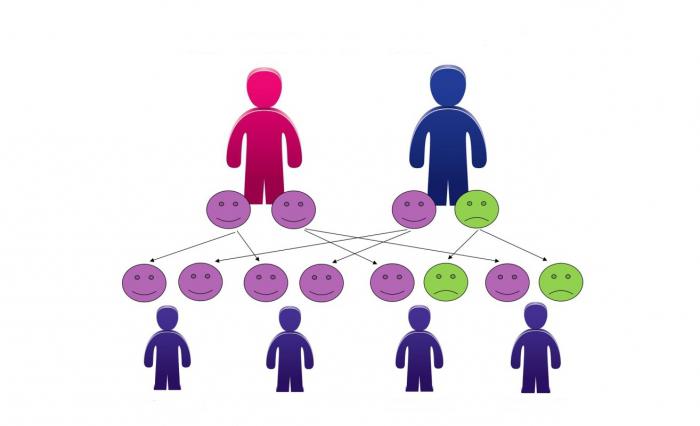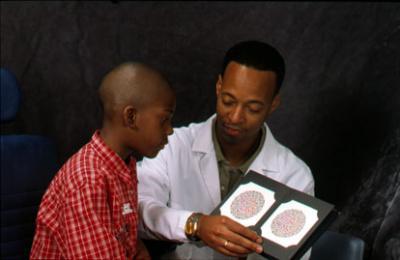The number of various diseases that can significantly limit the human activity and even lead to death is constantly growing. In this case, it is worth understanding an important fact: some of the pathologies that violate the functions of the body are not acquired, but, as they say, are rooted in genetics. We are talking about the inheritance of autosomal traits transmitted from generation to generation.
What should be understood as an autosomal trait
Going deeper into the essence of this term, it is important first of all to pay attention to such a property of any living creature as heredity. In most cases, children are similar to their parents, but at the same time, certain differences are almost always noticeable among representatives of the same family.
In other words, each has its own individual characteristics, but they are actually part of the genetic heritage. Thus, an autosomal trait is nothing more than an inheritance of the genetic traits of the parents.
Disease transmission
In addition to specific individual characteristics, a person can inherit some diseases from his father and mother. This fact is due to the influence of mutations in genes that are localized in autosomes. Moreover, these signs can be divided into two key areas: dominant and recessive. Both of them have a significant impact on the structure of the heritage of a particular person.
Autosomal dominant trait
Each type of inheritance has its own characteristics. If we consider autosomal dominant, it is worth noting that in this case, to obtain the disease by the hereditary route, it is sufficient to transmit the mutant allele of any of the parents. This sign of inheritance can equally occur in both men and women. In fact, autosomal dominant inheritance can be defined as the transmission of a trait that is controlled by the dominant allele of the autosomal gene. With this type of inheritance, a single mutant allele localized in the autosome will be sufficient for the manifestation of the disease.

The good news is that most diseases that are transmitted in this way do not cause significant harm to health, nor do they have a significant detrimental effect on human reproductive functions. If we compare the level of influence on the percentage of diseases, then dominant signs often cause any deviations than recessive ones. In the presence of such a mutation in one of the spouses with full health of the second, the risk of transmission of the disease is 50%. For this reason, an autosomal dominant trait, manifested in the form of a mutation, can be transmitted from generation to generation and, thus, have a family character. Unlike autosomal recessive ones, these characters are manifested in heterozygotes, which have one mutant and one normal allele on homologous chromosomes.
Autosomal dominant inheritance disorders
With this type of transmission of hereditary traits, a heterozygous mutation carrier is sufficient for the next generation of the disease. An interesting fact is that the dominant autosomal trait implies the same incidence of diseases in both girls and boys.
If the disease resulting from the effect of this type of heredity transmission is present in the child, while both parents are healthy, this fact means the emergence of a new mutation in the germ cells of the mother or father. It is important to understand that in one family the effect of a dominant gene on the condition of children may vary. This means that the clinical picture and severity of the disease will not necessarily be the same.
Disease Examples
An autosomal trait of a dominant type is clearly manifested through a disease such as Marfan syndrome. A similar diagnosis means that the connective tissue is affected in the human body. Patients with Marfan syndrome usually have thin thin fingers, and the length of the limbs is disproportionate. Such people often develop aortic and heart valve defects.
Another hereditary disease, which is determined by the presence of autosomal dominant signs of inheritance, is brachidactyly, which is also short-toed. This is a fairly rare sign found in one of the parents. The manifestation of this disease is noticeable already in the first time after birth due to an unnatural change in the phalanges of the toes and hands.
Hereditary deafness is an autosomal trait that can also be defined as dominant.
Amyotrophic lateral sclerosis (ALS, or Charcot's disease) is also a consequence of an autosomal dominant trait of inheritance and belongs to the group of motor-neural diseases. This disease can be defined as a fatal, progressive, neurodegenerative disorder, which was caused by the degeneration of cells of the central nervous system - motor neurons. The main function of these cells is to maintain muscle tone and ensure motor coordination.
Autosomal recessive trait: features
This type of inheritance has several key characteristics:
- may not affect the condition of children even if there were many carriers of a hereditary disease in the pedigree, since recessive characters do not appear in every generation (horizontal inheritance, as opposed to dominant characters);
- a recessive mutant gene (a) appears phenoptically only when it is in a homozygous state (aa);
- hereditary disease manifests itself equally often both in women and men;
- the likelihood that a born child will be sick significantly increases in the case of family marriages;
- Phenoptically healthy parents of a child with a manifested disease can be heterozygous carriers of a mutant gene.
It should be noted that among all hereditary pathology, recessive autosomal inheritance of characters is the most common. Diseases that can be determined as a consequence of this symptom include a large group of enzymes that lead to metabolic disorders, blood diseases (including homeostasis), kidneys, the immune system, etc.
Examples of autosomal recessive diseases
- Girke's disease (glycogenosis) can be attributed to this group of signs. The manifestation of this genetic disorder is due to a deficiency of the enzyme glucose-6-phosphatase, which leads to a significant deterioration in the ability of the liver to reproduce glucose. Violation of such an important process inevitably leads to hypoglycemia.
- Maple syrup disease is also an autosomal symptom that can be defined as recessive. This disease has another name - leucinosis. Such a diagnosis implies a metabolic disorder resulting from improper metabolism of branched chain amino acids. This disease can be attributed to organic acididemia.
- Tay-Sachs disease, which also has such names as early childhood amavrotic idiocy and hexosaminidase deficiency. This disease is a genetic autosomal recessive and leads to a progressive deterioration in the physical and mental abilities of the child.
- It is worth noting that, unlike a disease such as deafness, the autosomal sign of color blindness is recessive, but it can also be categorized as “sex-linked”. Impaired color perception can be either partial or complete. The most common is a distorted perception of red. It is worth noting that in some cases, a disturbed perception of a particular color is compensated by a better distinction of shades of other colors.

- Phenylketonuria is an autosomal recessive trait that implies a hereditary metabolic disease. This violation is caused by a deficiency of the phenylalanine enzyme.
What should be understood as sex-linked diseases
Diseases of this group are due to the fact that a man has one X chromosome, and women have two. Accordingly, the male, having inherited the pathological gene, is hemizygous, and the woman is heterozygous. Hereditary characters that are transmitted by the X-linked type may occur with different probabilities in representatives of both sexes.
If we consider the dominant X-linked inheritance of the disease, it is worth noting that such cases are more common in women. This is due to the increased possibility of obtaining a pathological allele from one of the parents. As for men, they are able to inherit a gene of this type only from their mother. Moreover, in the male line, the dominant autosomal trait linked to the X chromosome is transmitted to all daughters, while the sons do not show the disease, since they do not receive the father's chromosome.
If you pay attention to the autosomal recessive X-linked sign of inheritance, you can see that such diseases develop mainly in hemizygous men. In turn, women are in fact always always heterozygous and, therefore, phenoptically healthy. X-linked inherited traits include diseases such as Duchenne-Becker muscular dystrophy, hemophilia, Hunter syndrome, and others.
As for Y-linked inheritance, these signs are due to the presence of the Y-chromosome exclusively in men. The action of such a gene can only be transmitted from father to son for many generations.
Features of the mitochondrial inheritance method
This type of inheritance stands out among others in that the transmission of characters occurs through mitochondria located in the egg plasma. Moreover, the ring chromosome is located in each mitochondria, and there are approximately 25,000 of them in the egg cell. Gene mutations in the mitochondria occur when progressive ophthalmoplegia, mitochondrial myopathies, and Leberaf optic atrophy are present in the body. Diseases that are the result of this factor can be transmitted from the mother equally often to both daughters and sons.
In general, both autosomal unlinked characters and other types of hereditary mutations can significantly affect the physical condition of several generations and are the cause of many serious diseases.